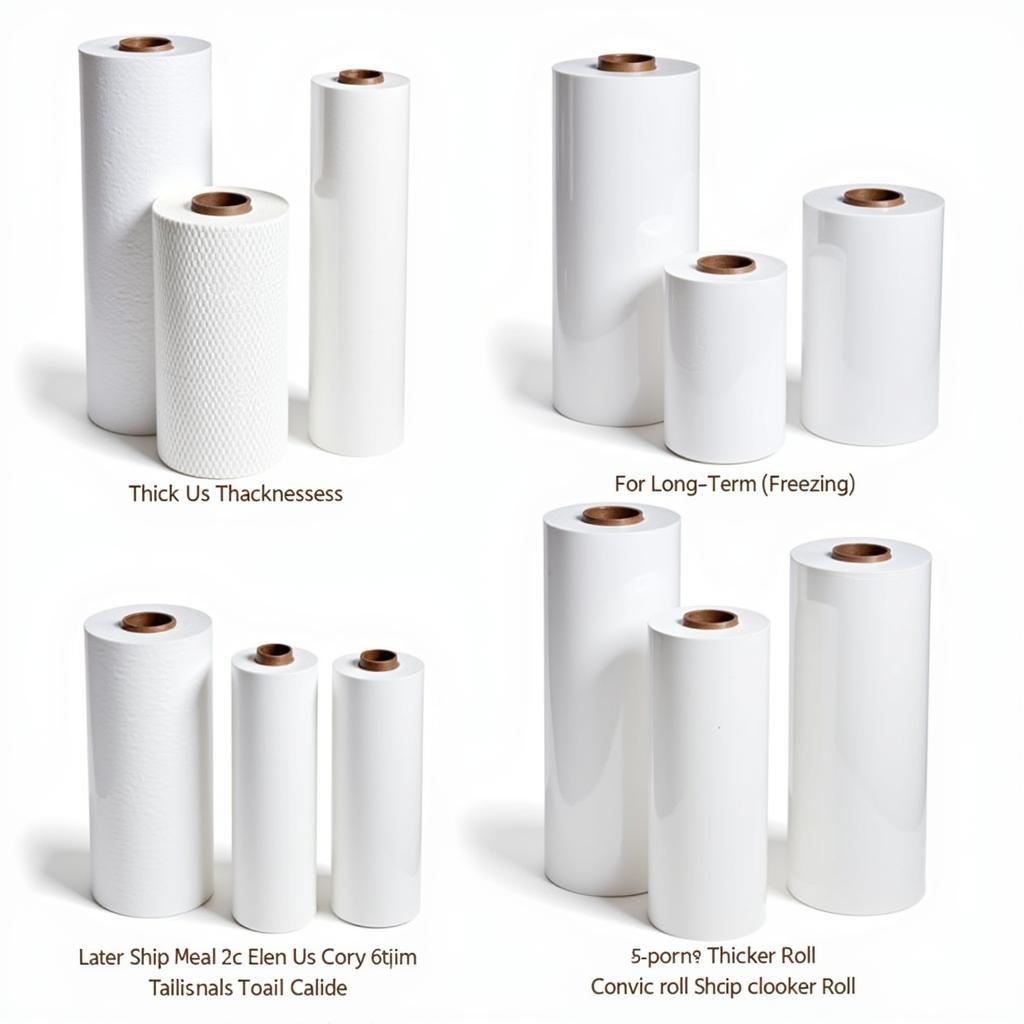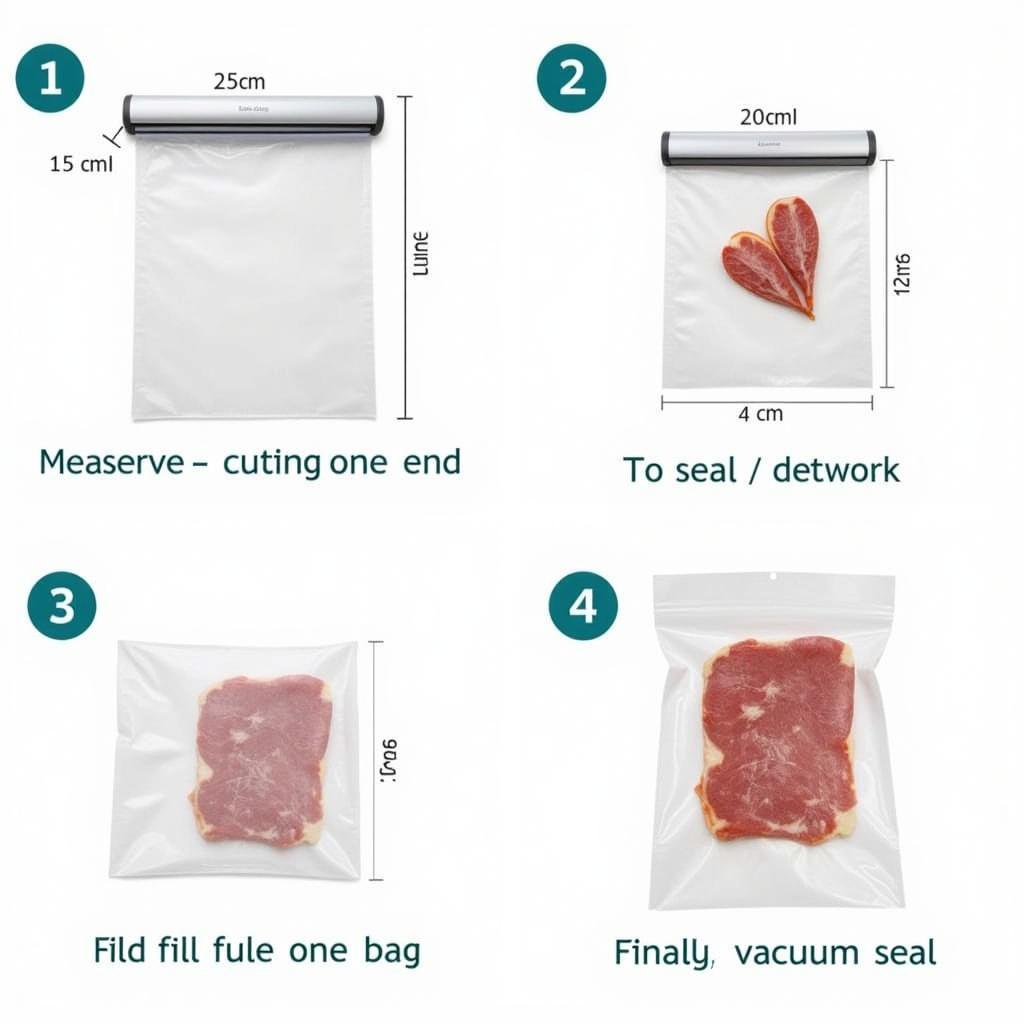Vacuum Food Sealer Rolls are essential for anyone looking to maximize food preservation and minimize waste. Whether you’re a seasoned chef or a home cook, understanding how to choose and use these rolls can drastically improve your kitchen efficiency and save you money in the long run. In this comprehensive guide, we’ll delve into everything you need to know about vacuum food sealer rolls, from selecting the right size and material to mastering various sealing techniques.
Choosing the Right Vacuum Food Sealer Rolls
Selecting the correct vacuum food sealer rolls depends on several factors, including the type of food you’re sealing and your storage needs. Are you sealing delicate fruits or robust cuts of meat? Will you be freezing the food or storing it in the pantry? These questions will guide you toward the ideal roll.
Material Matters: Exploring Different Roll Options
Vacuum sealer rolls are typically made from polyethylene (PE), a durable and food-safe plastic. However, you’ll find variations in thickness and texture. Thicker rolls offer superior protection against freezer burn and are ideal for long-term storage. For example, if you’re sealing a large cut of meat for sous vide cooking, a thicker roll is recommended. Thinner rolls are suitable for shorter-term storage and more delicate foods like vegetables or baked goods.
 Different Types of Vacuum Sealer Rolls
Different Types of Vacuum Sealer Rolls
Size it Up: Finding the Perfect Fit
Vacuum sealer rolls come in a variety of widths, allowing you to customize the size of your bags. Choosing the correct width minimizes waste and ensures a proper seal. Smaller widths are perfect for individual portions or smaller items, while larger widths are ideal for bulk storage, family meals, or larger cuts of meat. Don’t forget to consider the size of your vacuum sealer when selecting roll widths. Some sealers have limitations on the maximum width they can accommodate.
Mastering the Art of Vacuum Sealing with Rolls
Properly using vacuum food sealer rolls is just as important as choosing the right ones. Here’s a step-by-step guide to help you achieve an airtight seal every time:
-
Measure and Cut: Measure the desired length of the bag, adding a few extra inches for sealing. Cut the roll straight across using a sharp knife or the built-in cutter on your vacuum sealer.
-
Seal One End: Place one end of the cut roll onto the sealing bar of your vacuum sealer. Close the lid and press the “seal” button. This creates a bag from the roll.
-
Fill the Bag: Carefully place your food items into the newly created bag, leaving enough space at the top for sealing. Avoid overfilling the bag, as this can hinder the vacuuming process and potentially damage your sealer. You might want to consider a lem food saver for specific types of food.
-
Vacuum and Seal: Place the open end of the bag onto the sealing bar, close the lid, and select the “vacuum and seal” function. The sealer will remove the air from the bag and create an airtight seal.
 Properly Using Vacuum Sealer Rolls to Create Airtight Bags
Properly Using Vacuum Sealer Rolls to Create Airtight Bags
Benefits of Using Vacuum Food Sealer Rolls
Vacuum sealing offers a multitude of benefits, including:
- Extended Food Freshness: By removing air, vacuum sealing significantly slows down the oxidation process, keeping food fresh for up to five times longer than traditional storage methods.
- Reduced Food Waste: Preserve seasonal produce, leftovers, and bulk buys, minimizing spoilage and saving money.
- Freezer Burn Prevention: Vacuum sealing creates a barrier against freezer burn, protecting the flavor and texture of your frozen foods.
“Using vacuum sealer rolls allows me to buy in bulk and portion out meals for the week, saving me both time and money,” says renowned chef, Amelia Dupont. “The quality of the food remains impeccable, even after weeks in the freezer.”
Vacuum Sealer Rolls for Specific Needs
Looking for extra large vacuum seal bags for food? Or perhaps you are interested in food packaged on site for retail sale? Vacuum sealer rolls can cater to a wide range of needs.
Conclusion
Vacuum food sealer rolls are an indispensable tool for any kitchen. By understanding how to choose and use them effectively, you can significantly enhance your food preservation efforts, reduce waste, and enjoy fresh, flavorful meals for longer. Investing in high-quality vacuum food sealer rolls is an investment in the long-term freshness and quality of your food.
FAQ
-
Can I reuse vacuum sealer rolls? No, vacuum sealer rolls are designed for single use.
-
What is the best thickness for vacuum sealer rolls? The ideal thickness depends on your storage needs. Thicker rolls are better for long-term freezing, while thinner rolls are suitable for short-term storage.
-
Can I use vacuum sealer rolls with any vacuum sealer? Most vacuum sealer rolls are universal, but it’s always best to check your sealer’s specifications.
-
How long does vacuum sealed food last? Vacuum sealed food can last up to five times longer than food stored using traditional methods.
-
What types of food can I vacuum seal? You can vacuum seal a wide variety of foods, including meats, vegetables, fruits, and even liquids.
Common Scenarios
Scenario 1: You’ve bought a large quantity of fresh berries at the farmers market. Using vacuum sealer rolls, you can portion them out and freeze them for smoothies throughout the year.
Scenario 2: You’re preparing for a camping trip. Vacuum sealing your meals in individual portions ensures easy packing and minimizes the risk of spoilage.
Further Exploration
For more tips and tricks on food preservation, check out our other articles on food storage and vacuum sealing techniques.
Need Assistance?
For any questions or assistance, please contact us at Phone Number: 02437655121, Email: minacones@gmail.com or visit us at 3PGH+8R9, ĐT70A, thôn Trung, Bắc Từ Liêm, Hà Nội, Việt Nam. We have a 24/7 customer service team ready to help.